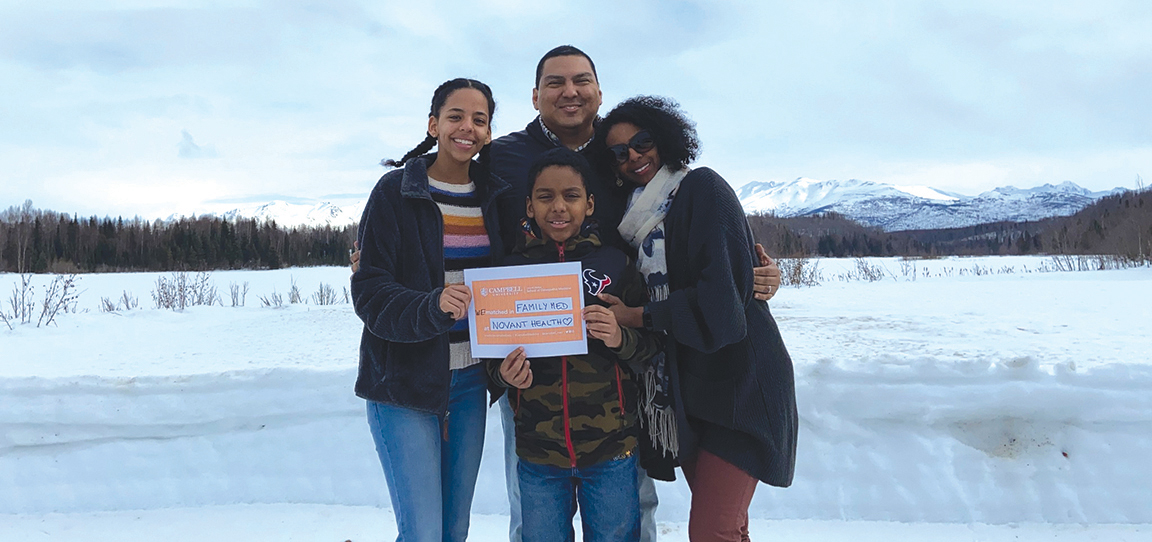Three-time Campbell grad and resident doctor Sarah Lassiter is passionate about serving in a small, medically underserved town like Coats, where patients need and trust a familiar face.
Story by Billy Liggett | Photography by Ben Brown
It’s 9:30 a.m. on an unusually warm day in March, and Dr. Sarah Ryals Lassiter has already seen an elderly patient in for a Medicaid wellness exam, a young woman with questions about contraception options, a young adult taking medications for anxiety and depression, a pregnant woman in for a check-up and a patient asking if they needed a medication refill. This, she says — without a hint of irony in her delivery — is a slow day.
This diversity of need is common in family clinics, and doctors like Lassiter are absolutely critical in rural areas like Coats, a town of just over 2,000 people barely four miles from the Jerry M. Wallace School of Osteopathic Medicine. She’s one of a handful of Campbell University doctors looking to complete their residencies in family medicine at Coats Medical Clinic, a Harnett Health physician practice. In the morning, she’s a family doctor. In the afternoon, she’s part of the OB/GYN team at Betsy Johnson Hospital in nearby Dunn.
By “serving the underserved,” Lassiter has been living the mission of Campbell’s med school in the year since earning her doctorate. She’s also living her dream — having grown up in the tiny community of Meadow (on the east side of I-95), Harnett County is and always has been her home. Many of her patients know her and her family. Those who don’t know her at least recognize the names “Ryals” and “Lassiter,” both common surnames the region.
Familiarity can breed trust, and trust is important in a physician-patient relationship. And trust can be a life-saver in a rural area, where the population is five times more likely to die from leading causes such as heart disease, cancer, respiratory illness and stroke.
“We refer to family medicine as ‘cradle-to-grave care,’” Lassiter says from her desk, taking her first “break” of the morning to fill out reports. “We take care of you from the moment you take your first breath until the minute you die. And that’s the draw for me. I have some patients who I see the mom, the dad, the kids and the grandparents — you become more than just a doctor in those situations. You become a part of their little family unit.

__________
“Because of that, trust goes a long way in medicine. If you trust your doctor, you’re more apt to listen to their advice, [or] to tell them your problems — no matter how personal — so they can treat you better and more holistically. I think that’s what Campbell University had in mind when they started the med school.”
It’s exactly what Campbell had in mind. It’s also what Dr. W. Donald Moore had in mind when he opened Coats’ first family clinic in August of 1949, fresh off of a two-year mission trip caring for underserved families in rural China. Moore was a beloved family doctor in the community for over 50 years, and in 1979, his daughter, Dr. Linda Robinson, joined the practice, making them the first father-daughter family practice group in North Carolina.
Robinson took over following Moore’s death in 2004, and when Campbell University launched its med school nine years later, she happily opened her clinic to residents interested in family medicine. Today, the Coats clinic houses up to 12 Campbell resident doctors, with four attending physicians overseeing their work. And Robinson, now in her 44th year of family medicine, looms large as the symbolic matriarch of the operation.
“Even before I worked here, I knew who Dr. Robinson was. I saw patients or had family members who saw her, and they’d tell me about the impact she had on their lives,” Lassiter says. “It really shows you how important a family provider can be in a community. I’ve heard people say things like, ‘She saved my mom from having a heart attack, because she sent her to the hospital at just the right time,’ or other little preventative things that save lives. When someone has been practicing in one community for this long, you see the lives they change. You want the same things in your own career.”
Lassiter was 13 when she decided she wanted to become a doctor. It was an eighth-grade career development day, and students were asked to talk about what they wanted to be when they grew up. Lassiter wasn’t the best student at the time, and her declaration was met by a few laughs from her classmates. But she remembers her principal stepping in and instilling confidence in her that it wasn’t such an unreachable dream.
“He said, ‘Well, you know, it’s really hard to be a doctor. But if that’s what you want to do, then I believe you’re going to do it.’ And he was the first person who believed in me and made me think this was really an option. I grew up in a farming community, and I would eventually become a first-generation college student. My parents always told me I could be whatever I wanted to be, but there was always this kind of unspoken … limitation, I guess. I refused to let it hold me back.”
The seed planted, Lassiter began taking more difficult classes in high school. She reached out of her comfort level in higher-level science classes. She applied to Campbell University, and in a moment of perfect planet alignment, she learned the news during her Accepted Students Day on campus that Campbell was planning to build the state’s first new medical school in over 35 years. For the first time, she heard the term “osteopathic medicine,” and for the first time, the idea of studying and practicing medicine in her home county seemed like an attainable goal.

__________
“Campbell made it clear they wanted people to serve in rural communities,” she recalls. “They told me they were building this school for people like me. So at that point, it just felt like everything fell into place.”
From that point on, it was med school or bust. She piled on the pre-med courses and even worked as a certified nursing assistant at Johnston Health while an undergrad. Four years later, she applied for medical school during her senior year.
She didn’t get in.
Her MCAT scores were too low — an insight she’s not at all embarrassed to share seven years later. Nationally, about 60 percent of those who apply to med school are rejected. But Lassiter was excited to learn Campbell has a “backup plan” for students like her — the Master of Science in Biomedical Sciences program is a rigorous two-year curriculum taught by med school faculty, designed for students who need to enhance either their academic record or standardized test scores. Many of the program’s students are underrepresented minorities, come from low socioeconomic backgrounds or — as in Lassiter’s case — come from rural areas.
“It made me feel like Campbell had all this support for me, and they weren’t going to give up on me,” Lassiter says. “So I didn’t want to give up either. [The master’s program] made me a more well-rounded student, and it made med school a little less intimidating. I was more prepared to be flexible with my study habits. And I already knew some of the professors and what expectations they would have for me.
“You don’t get that kind of support from larger institutions.”
In her third and fourth years of medical school, Lassiter’s rotations took her to Johnston Health and at clinics in Smithfield, Clayton and Benson — this during the height of the COVID-19 pandemic. The experience was an eye-opener, as she saw first-hand the shortage of physicians in rural communities and the negative impact that can have on patients. The experience also justified her decision to stay local, stay rural and practice where the need is greatest.
“Even in Clayton, where it’s mostly suburbs now, there were so many patients I saw in the emergency room, because that was their last resort when they couldn’t get an appointment with a primary doctor,” she says. “Maybe it’s cliché, but these are my people. And if that was my mom or dad, I’d hate to see them throwing money down the drain by going to the ER when a clinic is right there. I’d want a doctor who’s willing to do more for them.”

__________
Dr. Jennifer Hill, one of the full-time primary care providers in Coats and one of Lassiter’s attending physicians, hails from a much different background. Born and raised in San Diego, she had her sights on becoming a doctor in elementary school, embarrassing her mom once in a bank when — anatomy book in hand — she told the teller how a bladder works.
Hill traveled cross-country to Buies Creek, because Campbell was the first med school to accept her. She remembers getting lost on her first drive to the school (she blames Apple Maps) and pulling over to figure it out. “Multiple people stopped to check on me,” she says. “And, at first, it was kind of disturbing. But then I realized North Carolina is different — people are very friendly here. I’ve gotten very used to it now.”
Different backgrounds, but the same desire to serve. In addition to her work in Coats, Hill is the director of student medical education for the med school’s Harnett region. She and her husband fell in love with North Carolina, and she feels needed in Coats.
“Over half of our patients are on Medicaid and Medicare, and we’re able to provide them with resources they otherwise wouldn’t have,” she says. “And then I see our residency program — our doctors have more time with patients, especially in their first year. They really get to know them and have time to do more counseling. I think it’s really important to be able to empower patients to take ownership of their own health.”
In Lassiter, she sees a physician whose strength is connecting with patients. Her patients “adore” her, she says. And she’s a careful, thorough physician. Not bad for a young doctor whose friends in middle school laughed at the idea of her donning a white coat.
“I think it’s unique that I grew up in this area, and now I’m practicing here,” Lassiter says. “My family had a lot of health issues, and I understand better now the factors behind those conditions. I think as primary care doctors, we can come in and not only treat patients, but educate them and help them understand why they’re taking certain medications and why it’s important to check in regularly.
“I’ve learned that when these patients — my family, myself, my community — are non-compliant, it’s not because they want to be. Often it’s because they don’t always understand what we’re telling them. They can’t read our minds. Having more educational opportunities for them would just be so beneficial to everyone. I think this is where someone like me can make change or make a real difference in a community.”
Residents-Elect
Ninety-nine percent of Jerry M. Wallace School of Osteopathic Medicine students graduating this spring “matched” with a residency program — 43 of them staying in North Carolina and the rest representing 29 other states (and Washington, D.C.). On the flipside, 400-plus Campbell residents — from medical schools all over the country — are currently training in six Campbell-affiliated hospital systems.
Residency is an important last-step of education for a DO or an MD. By the fourth year of a medical student’s med school journey, they usually know which specialty they want to explore — that’s when the application process begins. Schools like Campbell then celebrate their “Match Days,” often in late March, to announce where their students will be heading.
“Residency, for me, is where I’ve received the most hands-on experience,” says Dr. Sarah Ryals Lassiter, a 2022 Campbell med school graduate currently in her family medicine residency at Coats Medical Clinic for the Harnett Health system. “In your rotations, you’re out there, but you’re really not in charge of anything. You’re mostly doing a lot of shadow procedures. [Residency] gives you more responsibility and allows you to become a practicing physician in your own right.”
Campbell’s residency program has grown with the school since its first graduating class in 2017, according to Dr. Brian Kessler, dean of Campbell’s med school. “We believe that continuing to offer more residency and fellowship programs in specialties of need within the state will create additional opportunities to retain students in rural and underserved communities in North Carolina and the southeastern United States.”



